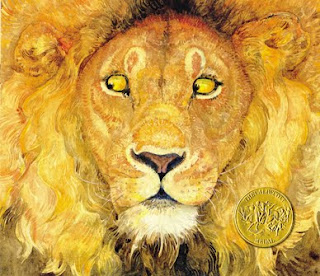
Pinkney, Jerry. The Lion and the Mouse. New York: Little, Brown and Company, 2009.
ISBN: 978-0-316-01356-7
PLOT SUMMARY
The Lion and the Mouse is a story of friendship. Placed in an African Serengeti, the lion and the mouse find themselves amidst a problem. The lion becomes trapped by hunters and finds himself in need of help. Eventually, after the Lion calls out for help the mouse comes to rescue. In the end, both the mouse and the lion return to happy families!
CRITICAL ANALYSIS
The illustrations in this story are absolutely stunning. The illustrator used a variety of colors to bring out the details of the animals in the story. The illustrations look like they’ve been drawn with colored pencil. The content on each page is very detailed and makes each picture a story in itself. The pictures in this book range from full (across the seam of the book) illustrations to smaller illustrations drawn on one page within a box. This variety keeps the reader very interested in the plot.
This story has no dialog, which is very interesting. There are several onomatopoeia's in this story. The mice say “squeak, squeak, squeak” and the owls say “who, who”. I found it very different and educational to include the animal’s sounds but no dialog. This gives a ‘teachable moment’ for both librarians and teachers by allowing younger students to identify which animals might makes those sounds. The Lion and the Mouse won the Caldecott Medal in 2009 and has been widely recognized for its distinctive illustrations. Overall, this is a very beautifully illustrated children’s fable and gives a reader a chance to let their imagination guide the story.
REVIEW EXCERPT(S)
· School Library Journal- “Beautifully designed and rendered artwork… make this book stand out.”
· Booklist- “Delightful… just right for [a] preschool audience.
CONNECTIONS
· Drawing Conclusions: Given that there isn’t any major dialog in the story gives the reader a chance to guide the story’s plot. A fun activity could be creating the words for the story. Each student could create the text for the picture and compare to what other students thought about the illustrations. This activity is more appropriate for grades 3-6.
· Having young students identify the sounds of the animals to a picture of the animal. This would be excellent for ESL learners as well.
No comments:
Post a Comment